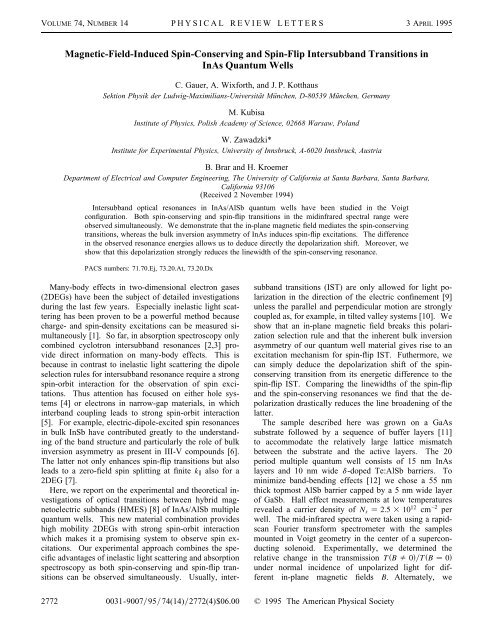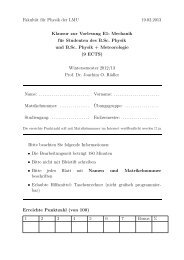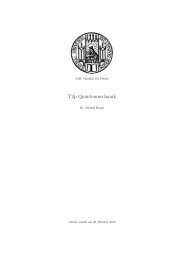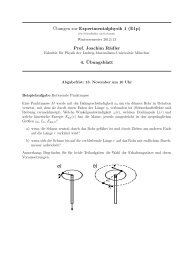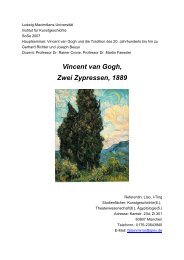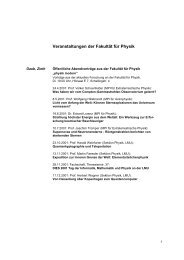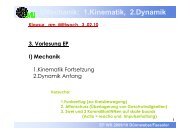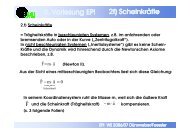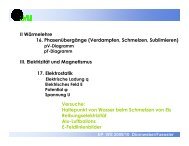Magnetic-Field-Induced Spin-Conserving and Spin-Flip ...
Magnetic-Field-Induced Spin-Conserving and Spin-Flip ...
Magnetic-Field-Induced Spin-Conserving and Spin-Flip ...
You also want an ePaper? Increase the reach of your titles
YUMPU automatically turns print PDFs into web optimized ePapers that Google loves.
VOLUME 74, NUMBER 14 PHYSICAL REVIEW LETTERS 3APRIL 1995<br />
<strong>Magnetic</strong>-<strong>Field</strong>-<strong>Induced</strong> <strong>Spin</strong>-<strong>Conserving</strong> <strong>and</strong> <strong>Spin</strong>-<strong>Flip</strong> Intersubb<strong>and</strong> Transitions in<br />
InAs Quantum Wells<br />
C. Gauer, A. Wixforth, <strong>and</strong> J. P. Kotthaus<br />
Sektion Physik der Ludwig-Maximilians-Universität München, D-80539 München, Germany<br />
M. Kubisa<br />
Institute of Physics, Polish Academy of Science, 02668 Warsaw, Pol<strong>and</strong><br />
W. Zawadzki*<br />
Institute for Experimental Physics, University of Innsbruck, A-6020 Innsbruck, Austria<br />
B. Brar <strong>and</strong> H. Kroemer<br />
Department of Electrical <strong>and</strong> Computer Engineering, The University of California at Santa Barbara, Santa Barbara,<br />
California 93106<br />
(Received 2 November 1994)<br />
Intersubb<strong>and</strong> optical resonances in InAs/AlSb quantum wells have been studied in the Voigt<br />
configuration. Both spin-conserving <strong>and</strong> spin-flip transitions in the midinfrared spectral range were<br />
observed simultaneously. We demonstrate that the in-plane magnetic field mediates the spin-conserving<br />
transitions, whereas the bulk inversion asymmetry of InAs induces spin-flip excitations. The difference<br />
in the observed resonance energies allows us to deduce directly the depolarization shift. Moreover, we<br />
show that this depolarization strongly reduces the linewidth of the spin-conserving resonance.<br />
PACS numbers: 71.70.Ej, 73.20.At, 73.20.Dx<br />
Many-body effects in two-dimensional electron gases<br />
(2DEGs) have been the subject of detailed investigations<br />
during the last few years. Especially inelastic light scattering<br />
has been proven to be a powerful method because<br />
charge- <strong>and</strong> spin-density excitations can be measured simultaneously<br />
[1]. So far, in absorption spectroscopy only<br />
combined cyclotron intersubb<strong>and</strong> resonances [2,3] provide<br />
direct information on many-body effects. This is<br />
because in contrast to inelastic light scattering the dipole<br />
selection rules for intersubb<strong>and</strong> resonance require a strong<br />
spin-orbit interaction for the observation of spin excitations.<br />
Thus attention has focused on either hole systems<br />
[4] or electrons in narrow-gap materials, in which<br />
interb<strong>and</strong> coupling leads to strong spin-orbit interaction<br />
[5]. For example, electric-dipole-excited spin resonances<br />
in bulk InSb have contributed greatly to the underst<strong>and</strong>ing<br />
of the b<strong>and</strong> structure <strong>and</strong> particularly the role of bulk<br />
inversion asymmetry as present in III-V compounds [6].<br />
The latter not only enhances spin-flip transitions but also<br />
leads to a zero-field spin splitting at finite k k also for a<br />
2DEG [7].<br />
Here, we report on the experimental <strong>and</strong> theoretical investigations<br />
of optical transitions between hybrid magnetoelectric<br />
subb<strong>and</strong>s (HMES) [8] of InAs/AlSb multiple<br />
quantum wells. This new material combination provides<br />
high mobility 2DEGs with strong spin-orbit interaction<br />
which makes it a promising system to observe spin excitations.<br />
Our experimental approach combines the specific<br />
advantages of inelastic light scattering <strong>and</strong> absorption<br />
spectroscopy as both spin-conserving <strong>and</strong> spin-flip transitions<br />
can be observed simultaneously. Usually, intersubb<strong>and</strong><br />
transitions (IST) are only allowed for light polarization<br />
in the direction of the electric confinement [9]<br />
unless the parallel <strong>and</strong> perpendicular motion are strongly<br />
coupled as, for example, in tilted valley systems [10]. We<br />
show that an in-plane magnetic field breaks this polarization<br />
selection rule <strong>and</strong> that the inherent bulk inversion<br />
asymmetry of our quantum well material gives rise to an<br />
excitation mechanism for spin-flip IST. Futhermore, we<br />
can simply deduce the depolarization shift of the spinconserving<br />
transition from its energetic difference to the<br />
spin-flip IST. Comparing the linewidths of the spin-flip<br />
<strong>and</strong> the spin-conserving resonances we find that the depolarization<br />
drastically reduces the line broadening of the<br />
latter.<br />
The sample described here was grown on a GaAs<br />
substrate followed by a sequence of buffer layers [11]<br />
to accommodate the relatively large lattice mismatch<br />
between the substrate <strong>and</strong> the active layers. The 20<br />
period multiple quantum well consists of 15 nm InAs<br />
layers <strong>and</strong> 10 nm wide d-doped Te:AlSb barriers. To<br />
minimize b<strong>and</strong>-bending effects [12] we chose a 55 nm<br />
thick topmost AlSb barrier capped by a 5 nm wide layer<br />
of GaSb. Hall effect measurements at low temperatures<br />
revealed a carrier density of N s 2.5 3 10 12 cm –2 per<br />
well. The mid-infrared spectra were taken using a rapidscan<br />
Fourier transform spectrometer with the samples<br />
mounted in Voigt geometry in the center of a superconducting<br />
solenoid. Experimentally, we determined the<br />
relative change in the transmission TB fi 0TB 0<br />
under normal incidence of unpolarized light for different<br />
in-plane magnetic fields B. Alternately, we<br />
2772 0031-90079574(14)2772(4)$06.00 © 1995 The American Physical Society
VOLUME 74, NUMBER 14 PHYSICAL REVIEW LETTERS 3APRIL 1995<br />
could ratio the spectra against those of a reference<br />
substrate.<br />
In Fig. 1 we show a transmission spectrum of our<br />
sample taken under an oblique angle of 57 ± used in<br />
a ratio against a reference substrate (upper trace). In<br />
this conventional IST configuration the refraction of the<br />
incident light results in a finite electric field component<br />
perpendicular to the 2DEG as required to excite an IST<br />
at B 0 T. The extracted resonance position agrees<br />
quite well with the one theoretically expected. Also<br />
the oscillator strength is found to exhibit the calculated<br />
dependence on the tilt angle (not shown in the figure).<br />
In the Voigt configuration, i.e., the light incident perpendicular<br />
to the sample plane <strong>and</strong> the in-plane magnetic<br />
field, we obtain the lower traces of Fig. 1. The spectra<br />
have been taken between B 2 T <strong>and</strong> B 13 T with a<br />
reference at B 0. Surprisingly, we observe two well<br />
separated resonances—one at around E 100 meV A<br />
<strong>and</strong> a second at E 135 meV C. In an additional experiment<br />
which is not shown here we verified that for the<br />
in-plane light polarization no absorption is detectable at<br />
zero magnetic field. Hence, we conclude that both resonances<br />
A <strong>and</strong> C are induced by the magnetic field <strong>and</strong> gain<br />
strength at high fields. With increasing field, the position<br />
of line A shifts to higher energies from E 94 meV at<br />
B 2 TtoE109 meV at B 13 T, whereas the position<br />
of the much narrower line C remains almost constant.<br />
Furthermore, line C is symmetric, <strong>and</strong> its width does not<br />
depend on the magnetic field. Its integrated absorption,<br />
however, increases quadratically with the field (inset of<br />
Fig. 1). Comparing with the top trace, resonance C is<br />
readily identified as the depolarization shifted IST. This<br />
conclusion is based on the fact that the energetic position<br />
<strong>and</strong> line shape are almost identical in both spectra. The<br />
low-energy resonance A, on the other h<strong>and</strong>, gains oscillator<br />
strength by an increase of both the absorption depth<br />
<strong>and</strong> the linewidth. It is considerably broader than line C<br />
at all fields <strong>and</strong> also becomes more <strong>and</strong> more asymmetric<br />
as the magnetic field is increased.<br />
To underst<strong>and</strong> the spectra in more detail we calculate<br />
the single particle subb<strong>and</strong> energies within the framework<br />
of a three-level k p model [13] as a function of the<br />
parallel magnetic field, where bending of the quantum<br />
well bottom has been taken into account by first order<br />
perturbation theory. Throughout this Letter we choose the<br />
direction of growth <strong>and</strong> the electric confinement to be y<br />
while the magnetic field is applied in the z direction B k z.<br />
In Fig. 2 we plot the intersubb<strong>and</strong> transition energies<br />
DE for k x k z 0 <strong>and</strong> in the inset a schematic of<br />
FIG. 1. The upper trace shows a transmission spectrum of<br />
our InAs/AlSb multiple quantum well used in a ratio against<br />
a reference substrate with the radiation incident under an<br />
oblique angle of 57 ± . The strength of the resonance follows<br />
the same polarization dependence as expected for intersubb<strong>and</strong><br />
transitions. We are not yet certain how to interpret the small<br />
structures around E 90 meV as they may be caused by the<br />
ratio. In the magnetic field ratio of the same sample we show<br />
spectra TB fi 0TB 0 at in-plane magnetic fields B 2,<br />
4, 6, 8, 10, 11, 12, <strong>and</strong> 13 T. Both resonances A <strong>and</strong> C vanish<br />
at zero magnetic field, <strong>and</strong> their absorption increases at higher<br />
fields. The inset shows that the integrated absorption of line C<br />
depends quadratically on the magnetic field.<br />
FIG. 2. Single particle transition energies between the HMES<br />
for k x k z 0. The spin-conserving transitions differ only<br />
very little in energy while the spin-flip excitations are energetically<br />
more separated. As the b<strong>and</strong> parameters were<br />
take E g 0.42 eV, D 0.38 eV, <strong>and</strong> the Kane energy E p <br />
22.9 eV. The inset shows schematically the relevant subb<strong>and</strong><br />
edges as a function of the magnetic field. The spin-up branch<br />
is lower in energy than the spin-down branch because the electronic<br />
g factor of InAs is negative.<br />
2773
VOLUME 74, NUMBER 14 PHYSICAL REVIEW LETTERS 3APRIL 1995<br />
the relevant subb<strong>and</strong> edges as a function of magnetic<br />
field. From the four possible intersubb<strong>and</strong> excitations<br />
two are spin conserving, while the two others involve a<br />
spin flip. The transition energies are almost identical for<br />
j0 " !j1"<strong>and</strong> j0 # !j1#, <strong>and</strong> they shift only slightly<br />
at high magnetic fields. The spin-flip transition energies,<br />
on the other h<strong>and</strong>, are more widely separated. At B <br />
13 T the energetic difference between j0 " !j1# <strong>and</strong><br />
j0 " !j1#is about 15 meV for k k 0 <strong>and</strong> decreases<br />
to roughly 6 meV for k k k k E F . The splittings are to<br />
be compared with the line broadening for both the spinflip<br />
<strong>and</strong> the spin-conserving transitions which is governed<br />
by the nonparallel subb<strong>and</strong> dispersion of the first <strong>and</strong><br />
the second subb<strong>and</strong>s. For high carrier concentrations<br />
as present in our sample this mechanism dominates all<br />
other sources of line broadening. At B 0 T the single<br />
particle subb<strong>and</strong> spacings decrease by roughly 35 meV<br />
from k k 0 to k k k F 0.04 Å –1 , accounting for the<br />
linewidth of the IST in the single-particle picture. From<br />
this analysis we would thus not expect to resolve the four<br />
possible resonances.<br />
It is well known from Raman experiments that spinconserving<br />
IST are influenced by the depolarization field<br />
whereas spin-flip excitations are not [1]. As we interpret<br />
line A as a superposition of the spin-flip transitions <strong>and</strong><br />
line C as a superposition of the spin-conserving resonances,<br />
the energetic difference for B ! 0 T between<br />
both represents to a good approximation the depolarization<br />
shift. This interpretation is further supported by<br />
calculating the k k -dependent single particle transition<br />
energies which are in very close agreement with the B !<br />
0 position of resonance A. Moreover, the depolarization<br />
field reduces the line broadening of IST as has been<br />
predicted theoretically [14] <strong>and</strong> recently been observed in<br />
inelastic light scattering experiments [15]. In our case<br />
the depolarization-shifted line C has a full width at half<br />
maximum of roughly 8 meV which is much narrower than<br />
expected from the k k dependence of the subb<strong>and</strong> spacings.<br />
Line A, on the other h<strong>and</strong>, exhibits a pronounced lowenergy<br />
shoulder even at low magnetic fields where the<br />
spin splitting between both spin-flip transitions is much<br />
smaller than the linewidth.<br />
We now address the question how the spin-conserving<br />
transitions are excited with in-plane polarized light.<br />
Whereas only weak excitations caused by interb<strong>and</strong><br />
coupling in narrow-gap materials [16] are possible at<br />
B 0 T another excitation mechanism is predominant<br />
in the Voigt configuration for B fi 0 T. At finite magnetic<br />
fields the light wave polarized in the x direction<br />
(the “cyclotron resonance active” mode) is no longer<br />
transverse [17] but acquires an electric field component<br />
in the growth direction. The important fact is that this<br />
component Ey<br />
ind is proportional to the magnetic field B<br />
so that the intensity I of the depolarization shifted IST<br />
A varies as I ~ B 2 [8]. As shown in the inset of Fig. 1<br />
this is indeed what we find experimentally. The above<br />
reasoning also explains why even in the limit B ! 0 T<br />
we observe the full depolarization shift of line C.<br />
The excitation mechanism of the spin-flip transitions<br />
is of a completely different nature. As has been shown<br />
for bulk InSb [18] the b<strong>and</strong> nonparabolicity in narrowgap<br />
III-V semiconductors may induce combined spin-flip<br />
<strong>and</strong> cyclotron resonance excitations. Our calculations,<br />
however, suggest that for our samples, this mechanism<br />
is too weak to account for the observed resonance.<br />
Inversion asymmetry induced by external electric fields<br />
[19] also leads to the possibility of spin-flip excitations.<br />
The symmetry of our structure, however, rules out this<br />
mechanism, too. We thus conclude that here the inherent<br />
bulk inversion asymmetry is responsible for the spin-flip<br />
excitations at high k k values.<br />
The dominant inversion asymmetry terms in the Hamiltonian<br />
have the schematic form GP i P j 1 P j P i , where<br />
G is a material constant <strong>and</strong> P i,j the canonical momentum<br />
[20]. As these terms have only a small influence<br />
on the energy dispersion <strong>and</strong>, in particular, on the B dependence<br />
of the transition energies we may neglect them<br />
in the computation of the eigenenergies, but we do include<br />
bulk inversion asymmetry in the computation of the<br />
eight-component wave function <strong>and</strong> the Hamiltonian of<br />
electron-photon interaction. Since the value of G is not<br />
known for InAs, we take G 3¯h 2 2m 0 as in InSb [20]<br />
<strong>and</strong> assume a level broadening of ¯ht 5 meV. The depolarization<br />
effects are quantitatively taken into account<br />
by generalizing the approach of Ando [21] for the Voigt<br />
configuration.<br />
We obtain the following important results. The transition<br />
probability for the spin-flip processes increases<br />
strongly as a function of the magnetic field. The matrix<br />
elements of the two spin-conserving transitions are<br />
roughly equal <strong>and</strong> about twice as large as for both spinflip<br />
transitions at all magnetic fields. Furthermore, all<br />
possible excitations are induced by the same radiation<br />
component a x . The other light component a z can be<br />
shown to give only a negligibly small contribution to the<br />
absorption. This prediction has been confirmed in an additional<br />
experiment with predominantly x-polarized light<br />
where the relative transmission for both types of excitations<br />
is significantly enhanced as compared to z-polarized<br />
light.<br />
For the above reason we show in the calculated spectrum<br />
of Fig. 3 only results for the polarization a x . In<br />
agreement with the experiment two peaks appear, although<br />
we deal with four transitions. The resonance at<br />
"v 135 meV represents the superposition of the two<br />
depolarization shifted spin-conserving transitions with almost<br />
equal transition energies <strong>and</strong> oscillator strengths.<br />
Their resonance width is drastically reduced by the<br />
depolarization field <strong>and</strong> not determined by the nonparabolicity<br />
broadening. Also, the resonance position is<br />
almost field independent as the depolarization shift decreases<br />
with increasing magnetic field. The broader peak<br />
2774
VOLUME 74, NUMBER 14 PHYSICAL REVIEW LETTERS 3APRIL 1995<br />
The work in Munich was sponsored by the Volkswagen<br />
Stiftung. The Santa Barbara group gratefully acknowledges<br />
support from the Office of Naval Research <strong>and</strong><br />
from QUEST, the NSF Science <strong>and</strong> Technology Center<br />
for Quantized Electronic Structures (Grant No. DMR 91-<br />
20007). The Munich–Santa Barbara cooperation is also<br />
supported by a joint NSF/European grant (Grant No. EC-<br />
US 015:9826).<br />
FIG. 3. Calculated transmission spectrum of the spinconserving<br />
<strong>and</strong> spin-flip transitions for light polarization a x .<br />
The calculation is carried out for magnetic fields between<br />
B 2 T <strong>and</strong> B 14 T with DB 2 T. Quantitative agreement<br />
is reached between our theoretical description <strong>and</strong> the<br />
experimental data.<br />
at lower energies results from a superposition of both<br />
spin-flip transitions which are not resolved because of the<br />
nonparabolicity-induced broadening <strong>and</strong> the reduced spin<br />
splitting at high values of k k . Both spin-flip transitions<br />
contribute with roughly the same oscillator strength to<br />
the absorption since the matrix elements are very similar<br />
<strong>and</strong> the occupation of the spin-split subb<strong>and</strong>s plays<br />
only a minor role because E splitting ø E F . In the final description<br />
the strengths of the spin-conserving <strong>and</strong> spin-flip<br />
transitions are almost the same as a result of the interplay<br />
between the matrix elements <strong>and</strong> the depolarization<br />
integrals. Hence, the very good agreement between the<br />
results of our calculation <strong>and</strong> the experimental observation<br />
gives strong support for the proposed mechanisms.<br />
To summarize, we have observed intersubb<strong>and</strong><br />
optical transitions in the Voigt geometry in InAs/AlSb<br />
quantum wells. We demonstrate that spin-conserving<br />
transitions can be induced by an in-plane magnetic field<br />
although the incident light is polarized in the plane of<br />
the two-dimensional electron gas. Furthermore, the joint<br />
action of bulk inversion asymmetry <strong>and</strong> an in-plane<br />
magnetic field are quantitatively identified to make a<br />
direct observation of intersubb<strong>and</strong> excitations involving<br />
a spin-flip possible. The simultaneous observation of<br />
spin-flip <strong>and</strong> spin-conserving transitions allows us to<br />
measure directly the depolarization shift in an infrared<br />
transmission experiment. Moreover, our results confirm<br />
the prediction that the depolarization effect strongly reduces<br />
the broadening of intersubb<strong>and</strong> resonances resulting<br />
from conduction b<strong>and</strong> nonparabolicity.<br />
*Permanent address: Institute of Physics, Polish Academy<br />
of Science, 02668 Warsaw, Pol<strong>and</strong>.<br />
[1] A. Pinczuk <strong>and</strong> G. Abstreiter, in Light Scattering in Solids<br />
V, edited by M. Cardona <strong>and</strong> G. Güntherodt (Springer-<br />
Verlag, Berlin, 1989), p. 153.<br />
[2] W. Beinvogl <strong>and</strong> J. F. Koch, Phys. Rev. Lett. 40, 1737<br />
(1978).<br />
[3] E. Batke, G. Weimann, <strong>and</strong> W. Schlapp, Phys. Rev. B 43,<br />
6812 (1991).<br />
[4] A. D. Wieck, E. Batke, D. Heitmann, J. P. Kotthaus, <strong>and</strong><br />
E. Bangert, Phys. Rev. Lett. 53, 493 (1984).<br />
[5] E. O. Kane, J. Phys. Chem. Solids 1, 249 (1957).<br />
[6] Y. F. Chen, M. Dobrowolska, J. K. Furdyna, <strong>and</strong><br />
S. Rodriguez, Phys. Rev. B 32, 890 (1985).<br />
[7] G. Lommer, F. Malcher, <strong>and</strong> U. Rössler, Phys. Rev. Lett.<br />
60, 728 (1988).<br />
[8] W. Zawadzki, Semicond. Sci. Technol. 2, 550 (1987).<br />
[9] T. Ando, A. B. Fowler, <strong>and</strong> F. Stern, Rev. Mod. Phys. 54,<br />
473 (1982).<br />
[10] A. D. Wieck, E. Batke, D. Heitmann, <strong>and</strong> J. P. Kotthaus,<br />
Phys. Rev. B 30, 4653 (1984).<br />
[11] G. Tuttle, H. Kroemer, <strong>and</strong> J. H. English, J. Appl. Phys.<br />
65, 5239 (1989).<br />
[12] C. Nguyen, B. Brar, H. Kroemer, <strong>and</strong> J. H. English, Appl.<br />
Phys. Lett. 60, 1854 (1992).<br />
[13] W. Zawadzki, S. Klahn, <strong>and</strong> U. Merkt, Phys. Rev. B 33,<br />
6916 (1986).<br />
[14] M. Zaluzny, Phys. Rev. B 43, 4511 (1991).<br />
[15] G. Brozak, B. V. Shanabrook, D. Gammon, D. A. Broido,<br />
R. Beresford, <strong>and</strong> W. I. Wang, Phys. Rev. B 45, 11 399<br />
(1992).<br />
[16] W. Zawadzki, J. Phys. C 16, 229 (1983).<br />
[17] W. Zawadzki, Adv. Phys. 23, 435 (1974).<br />
[18] B. D. McCombe, Phys. Rev. 181, 1206 (1969).<br />
[19] E. I. Rashba <strong>and</strong> V. I. Sheka, Fiz. Tverd. Tela 3, 1735<br />
(1961) [Sov. Phys. Solid State 3, 1257 (1961)]; Fiz. Tverd.<br />
Tela 3, 1863 (1961) [Sov. Phys. Solid State 3, 1357<br />
(1961)].<br />
[20] E. O. Kane, in Narrow Gap Semiconductors. Physics <strong>and</strong><br />
Applications, edited by W. Zawadzki (Springer-Verlag,<br />
Berlin, 1980), p. 13.<br />
[21] T. Ando, J. Phys. Soc. Jpn. 44, 475 (1978).<br />
2775


